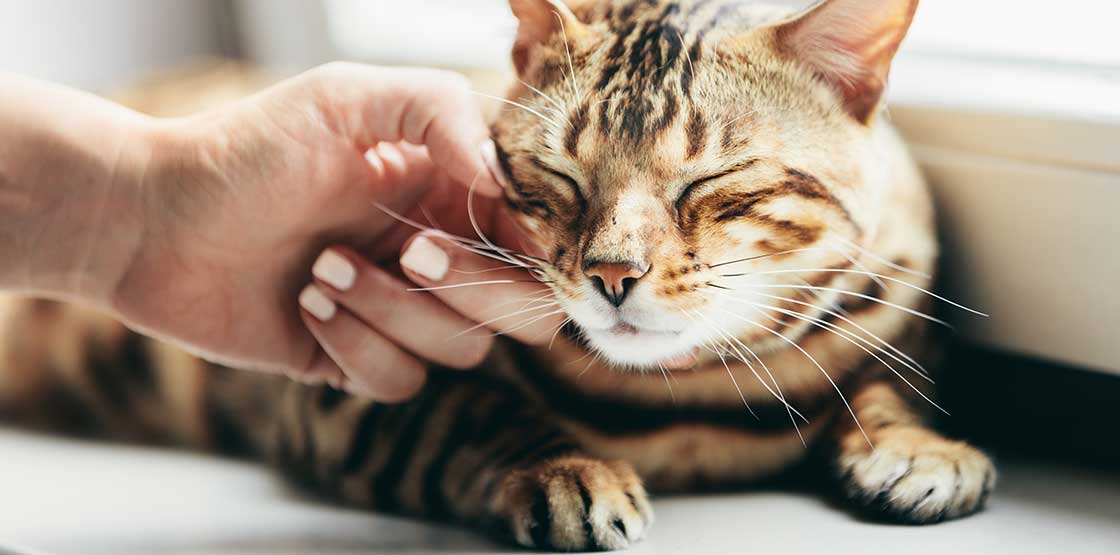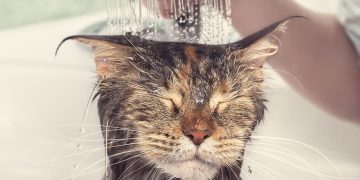What is Cat Chin Acne?
If you’ve noticed pimples on your cat’s chin, then it’s likely that they have a case of cat chin acne. Similar to the acne that humans get, our cats can find themselves with a collection of blackheads and whiteheads, usually under the chin, hence the name cat chin acne.
Now, the veterinary world isn’t too sure exactly why cat acne happens, but what they do know is that it’s called a disorder of follicular keratinization. So, follicular because it’s related to the hair follicle and then keratinization, which refers to the overproduction of a protein found in the skin called keratin.
When excess keratin becomes trapped in the hair follicle “blackheads” form. Then, when the blackhead becomes infected with bacteria “whiteheads” or “pimples” develop. In cat acne, the hair follicles can sometimes develop larger sores, which are known as furunculosis.
It’s also possible that an allergic reaction might cause the problem. So, that might be due to flea allergies, pollen, or fungal spores, or it could be caused by a product used in the home, such as a cleaning fluid.
One final reason for the development of cat chin acne is that it can be caused by a poorly groomed coat, which then causes skin infections. The longer-haired breeds, such as Himalayans and Persians, do seem to be much more likely to suffer from acne problems.
Symptoms of Cat Chin Acne
If your cat looks as if they have a dirty chin, a closer inspection might reveal that its actually acne causing that appearance. The acne can appear on the chin and also on the lower or upper lip.
When an infection has developed, then your cat’s lips and chin may become swollen and be sore to the touch. Both male and female cats seem to be at the same risk level of experiencing this skin problem.
How Can I Treat Cat Chin Acne?
Treatment for cat chin acne is often all about improved hygiene. Do remember not to use any human acne products on your cat. They are likely to much too strong for your cats’ skin and will just cause further skin irritation.
Before using any at-home acne treatments, we recommend that you take your cat to be seen by a vet who can then advise on the best approach to take.
Keeping the Area Clean
When recommended by your vet, chlorhexidine antibacterial washes can be a good way to clean the areas where the breakout is happening. This is usually recommended twice daily, and generally after they have eaten. This ensures that any food debris that might irritate the acne is cleaned off the face.
Ointments
Products such as benzoyl peroxide are sometimes recommended to unblock the hair follicles. Do be aware that some cats can find this very irritating, so you need to keep a close eye on them and seek veterinary advice if your cat becomes distressed.
Medicated Shampoos
Sometimes a mild antiseborrheic shampoo is prescribed to clean the problem areas, which also flushes out the follicles. If a secondary infection has taken hold, then an antibacterial or antifungal shampoo may be suggested.
Antibiotics
If the acne has become infected, then your vet may prescribe a short course of systemic antibiotics to speed recovery.
Omega 3
There is some evidence that fatty acid supplements promote healthy skin development and can also help treat cat chin acne.
You May Also Like:
Related Search Topics (Ads):
Warm Compress
If your cat’s acne is very mild, then you could try applying a washcloth that has been rinsed in warm water. This can really help to soothe the skin and reduce any swelling.
Homeopathic Medicine
There are two homeopathic medicines that can help skin conditions, and they’re hepar sulph and silica. Hepar sulph is said to act like an antibiotic and forces infection out of the body while silica is used to force foreign matter, such as abscess debris, out of the skin.
Clipping Fur
Clipping away the longer fur around the mouth can make it easier to clear the problem area and for it to be less irritating to the acne. Don’t attempt to do this at home, as you need to ensure that you don’t cause clipper rash, which can then result in further skin irritation.
Replace Plastic Water and Food Bowls
Some research suggests that plastic bowls may increase the likelihood of your cat experiencing acne. It’s not known why this happens, though it has been suggested that scratches on a plastic bowl can harbor bacteria, which then causes an infection. Swapping to ceramic or stainless-steel bowls is quick and easy to do, so it’s worth giving it a go.
How Can Cat Chin Acne Be Prevented?
Right now, we still don’t know what the causes of cat acne are but what we do know is that there are steps that you can take to reduce the likelihood of more problems in the future:
- Regular grooming will help you to quickly spot any issues before they become big problems.
- Switch to stainless steel or ceramic water and food bowls.
- Regularly clean the fur around your cat’s mouth if they tend to be a messy eater, have a long coat, or wrinkled skin.

